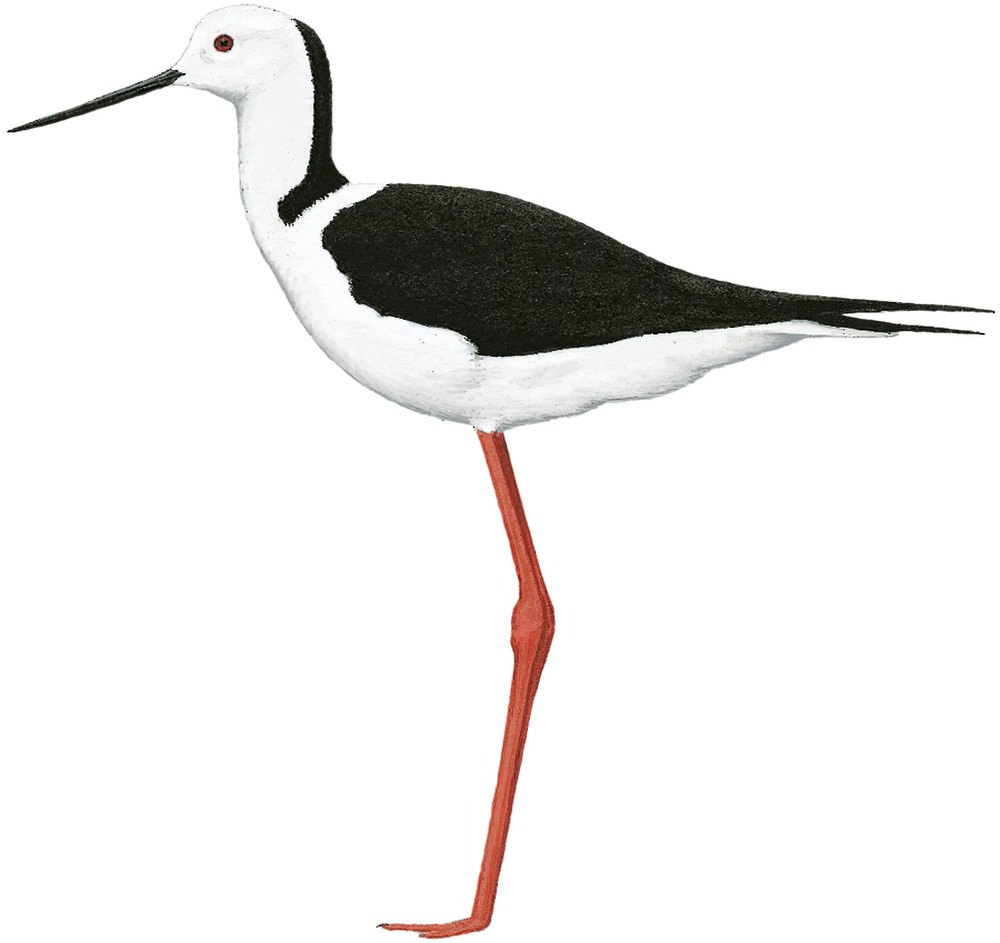Pied Stilt / Himantopus leucocephalus

Pied Stilt
SCI Name:
Protonym: Himantopus leucocephalus Syn.BirdsAustr. pt2 pl.34
Taxonomy: Charadriiformes / Recurvirostridae / Himantopus
Taxonomy Code: piesti1
Type Locality: Australia, Java and Sumatra.
Author: Gould
Publish Year: 1837
IUCN Status:
DEFINITIONS
HIMANTOPUS
(Recurvirostridae; Ϯ Black-winged Stilt H. himantopus) L. himantopus, himantopodis wading bird now generally identified with the Black-winged Stilt < Gr. ἱμαντοπους himantopous, ἱμαντοποδος himantopodos wading bird, spindle-shanks < ἱμας himas, ἱμαντος himantos strap, thong; πους pous, ποδος podos foot; "Himantopus. Genus 67. ... Genus Himantopi. Le genre de l'Echasse. (1). ... (1) Echasse, nom que j'ai donné aux espèces de ce genre à cause de la longueur de leurs jambes. **1. L'ECHASSE. ... HIMANTOPUS." (Brisson 1760): based on "Himantopus" of ancient and later authors, and Charadrius Himantopus Linnaeus, 1758; "Himantopus Brisson, Orn., 1760, 1, p. 46; 5, p. 33. Type, by tautonymy, Himantopus Brisson = Charadrius himantopus Linné." (Peters, 1934, II, p. 289). The various allopatric subspecies of the Black-winged Stilt are each often treated as distinct and separate species (i.e. himantopus, leucocephalus, knudseni, mexicanus and melanurus).
Var. Himatopus.
Synon. Calobatus, Himantellus, Hypsibates, Macrotarsus.
himantopus
• Gr. ἱμαντοπους himantopous, ἱμαντοποδος himantopodos wading bird, spindle-shanks < ἱμας himas, ἱμαντος himantos strap, thong; πους pous, ποδος podos foot; "TRINGA HIMANTOPUS, Nobis. Bill much longer than the head, sub-arched; legs very long, toes semipalmated ... This new species, which I shot from a flock at Long Branch, New-Jersey, in the middle of July, is very remarkable for its anomalous characters. It connects still more closely than the other Tringa with subarched bills, the two genera Numenius and Tringa, since to other common traits, it unites the semipalmated toes; indeed, instead of placing it at the head of Tringa, we should place it at the last of Numenius, was it not for its long, slender, and delicate legs and toes." (Bonaparte 1826) (Calidris).
• L. himantopus, himantopodis wading bird now generally identified with the Black-winged Stilt < Gr. ἱμαντοπους himantopous, ἱμαντοποδος himantopodos wading bird, spindle-shanks < ἱμας himas, ἱμαντος himantos strap, thong; πους pous, ποδος podos foot; “The Legs and Thighs are of a wonderful length, very small and weak ... so that well and of right may it be called Himantopus, or Loripes, its Legs being soft and flexible like a thong or string” (Ray 1678); “The old name of himantopus is taken from Pliny: and, by an aukward metaphor, implies that the legs are as slender and pliant as if cut out of a thong of leather” (White 1789); "79. CHARADRIUS. ... Himantopus. 10. C. supra niger, subtus albus, rostro nigro capite longiore, pedibus rubris longissimis. Charadrius autumnalis. Hasselq. iter. 253. n. 29. Himantopus. Sibb. scot. . . t. 11. 13. Raj. av. 106. Aldr. orn. l. 20. c. 30. Gesn. av. Habitat in Europa australiore." (Linnaeus 1758) (Himantopus).
leucocephala / leucocephalos / leucocephalus
Gr. λευκοκεφαλος leukokephalos white-headed < λευκος leukos white;
-κεφαλος -kephalos -headed < κεφαλη kephalē head.
● "44. PSITTACUS. ... leucocephalus. 26. P. brachyurus viridis, remigibus cæruleis, fronte alba. Psittacus leucocephalus. Aldr. ornith. l. 11. c. 8. Raj. av. 31. Psittacus viridis, fronte alba, collo rubro. Frisch. av. 4. t. 46. Psittacus viridis, capite albo. Edw. av. 166. t. 166. Habitat in America. Corpus magnitudine Cuculi, viride pennis margine nigris. Caput supra & ad latera cæruleum; fronte oculorumque regione alba. Gula tota rubra. Remiges nigræ latere exteriore denudato cæruleæ. Rectrices æquales, virides, basi rubræ, apice flavescentes; at 1. 1. latere exteriore cæruleo; 6. 6. unicolores. Abdomen postice ferrugineum." (Linnaeus 1758) (Amazona).
● ex “White-headed Shrike” of Latham 1781 (syn. Artamella viridis).
● ex "White-headed Curlew" of Latham 1785 (?syn. Bostrychia hagedash).
● ex “Gavilán de Estero cabeza blanca” of de Azara 1802-1805, no. 13 (subsp. Busarellus nigricollis).
● ex “Héron de la côte de Coromandel” of d’Aubenton 1765-1781, pl. 906, “Héron violet” of de Buffon 1770-1786, and “Violet Heron” of Latham 1785 (syn. Ciconia episcopus).
● ex “Rauhfuss Geyer” and “Gelbbrauner Geyer” of Frisch 1733, “Falco” of Brisson 1760, and “White-headed Falcon” of Latham 1781 (syn. Falco peregrinus).
● ex “White-headed Frigate” of Latham 1785 (syn. Fregata aquila).
● ex “Bald Eagle” of Catesby 1731, and “Aigle à tête blanche” of Brisson 1760 (Haliaeetus).
● ex “Merle Dominiquain de la Chine” of Sonnerat 1782, and “White-headed Thrush” of Latham 1783 (Hypsipetes).
● ex “Gobe-mouche à ventre jaune de Cayenne” of d’Aubenton 1765-1781, pl. 569, fig. 2 (syn. Myiozetetes cayanensis).
● ex “White Vulture” and “Cinereous Vulture” of Willughhby 1676, “Vultur albus” of Ray 1713, “Vultur leucocephalus” of Brisson 1760, “Vautour de Norwège” of d’Aubenton 1765-1781, pl. 429, and “Petit Vautour” of de Buffon 1770-1783 (syn. Neophron percnopterus).
● ex “Bald pate” of Ray 1713, “Columba capite albo” of Sloane 1725, and “White-crown’d Pigeon” of Catesby 1731 (Patagioenas).
● ex “Martin-Pêcheur de Java” of d’Aubenton 1765-1781, pl. 757, “Martin-pêcheur à tête et cou couleur de paille” of de Buffon 1770-1786, and “White-headed Kingsfisher” of Latham 1782 (syn. Pelargopsis capensis javana).
● ex “White-headed Finch” of Latham 1787 (syn. Stagonopleura guttata).
● ex “Lindo azul cabeza blanca” of de Azara 1802-1805, no. 93 (syn. Stephanophorus diadematus).
● ex “Quatoztli” of Hernandez 1651, and Seba 1734-1745, and “Tangara brasiliensis leucocephala” of Brisson 1760 (unident.).
UPPERCASE: current genus
Uppercase first letter: generic synonym
● and ● See: generic homonyms
lowercase: species and subspecies
●: early names, variants, mispellings
‡: extinct
†: type species
Gr.: ancient Greek
L.: Latin
<: derived from
syn: synonym of
/: separates historical and modern geographic names
ex: based on
TL: type locality
OD: original diagnosis (genus) or original description (species)












